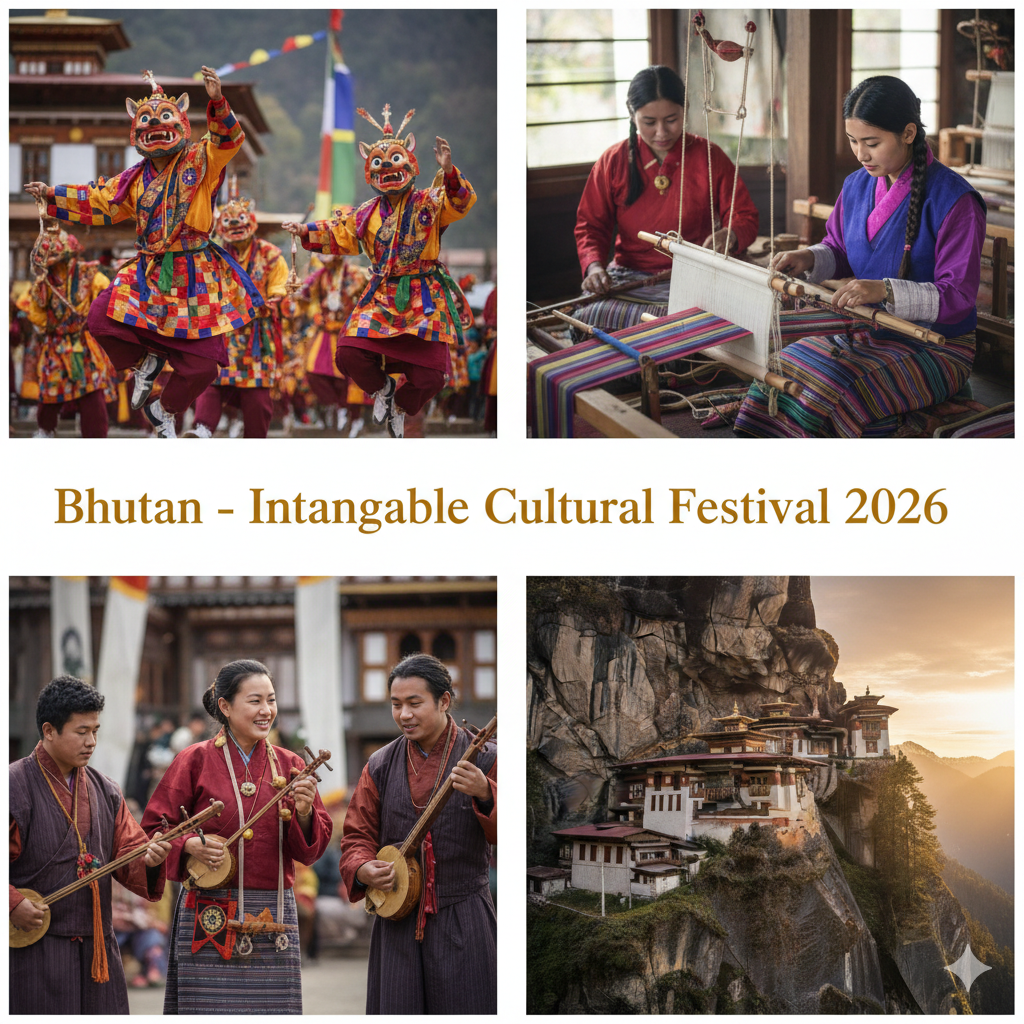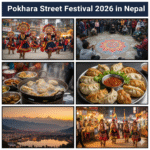A Living Museum in the Himalayas
Hidden between the towering peaks of the eastern Himalayas, Bhutan has long been known as the Land of the Thunder Dragon — a kingdom where tradition and spirituality breathe life into every valley, temple, and smile. In 2026, this mystical nation will unveil one of its most extraordinary cultural events: the Intangible Cultural Festival of Bhutan.
Unlike modern festivals filled with neon lights and massive stages, this one celebrates heritage, humanity, and harmony — an invitation to step into Bhutan’s living history. It’s not merely a performance; it’s a spiritual and cultural awakening.
This festival is Bhutan’s tribute to its intangible heritage — the oral traditions, folklore, crafts, rituals, and performing arts passed through generations. It’s an opportunity for travelers to experience the soul of Bhutan beyond the monasteries and mountains.
What Is the Intangible Cultural Festival of Bhutan 2026?
The Intangible Cultural Festival (ICF) is Bhutan’s grand initiative to preserve and showcase the nation’s non-material cultural heritage — the elements that define its identity but cannot be seen or touched, only felt and shared.
This includes:
- Oral traditions and ancient storytelling
- Traditional songs and dances
- Rituals and festivals linked to spirituality
- Craftsmanship and art forms
- Local customs, food heritage, and beliefs
The 2026 edition will bring together monks, artisans, performers, and elders from every district to share their unique heritage with both Bhutanese citizens and international visitors.
It’s not just a festival — it’s a cultural dialogue between generations and civilizations.
Festival Dates and Venue
- Event Name: Intangible Cultural Festival of Bhutan 2026
- Dates: October 16 – October 22, 2026
- Main Venue: Thimphu, with regional exhibitions in Paro, Punakha, and Bumthang
- Organized by: The Department of Culture, Ministry of Home and Cultural Affairs, Royal Government of Bhutan
The festival is designed to rotate between regions, ensuring that each year, different communities get to showcase their local traditions and folklore.
The Meaning of “Intangible Heritage” in Bhutan
Bhutan’s culture is not stored in museums — it’s lived daily. “Intangible heritage” refers to the spiritual, creative, and emotional aspects that connect Bhutanese people to their ancestors and environment.
UNESCO defines Intangible Cultural Heritage as:
“Practices, expressions, knowledge, and skills that communities recognize as part of their cultural heritage.”
In Bhutan, this includes:
- Religious festivals (Tshechus) featuring mask dances and blessings
- Local storytelling traditions in Dzongkha and regional dialects
- Handicrafts like thangka painting, weaving, and wood carving
- Traditional songs (zhungdra, boedra)
- Ancient culinary practices using local ingredients and spiritual symbolism
The 2026 festival will highlight all these aspects through immersive performances and workshops.
Festival Highlights and Programs
The Intangible Cultural Festival 2026 will feature a diverse array of programs that blend performance, education, and interaction. Here’s what visitors can look forward to:
1. Mask Dance Performances (Cham)
- Performed by Buddhist monks and laymen in colorful silk robes and intricate masks
- Symbolize the triumph of good over evil
- Accompanied by traditional horns, drums, and cymbals
2. Artisans’ Pavilion
- Live demonstrations of thangka painting, wood carving, blacksmithing, and handloom weaving
- Visitors can purchase certified handmade crafts directly from artisans
- Workshops for tourists to learn Bhutanese art techniques
3. Folk Music and Oral Traditions
- Nightly storytelling sessions under starry skies
- Performances of zhungdra, boedra, and regional folk songs
- Interactive cultural exchanges between local and international performers
4. Rituals and Monastic Blessings
- Sacred rituals performed by monks from Punakha Dzong and Trongsa monasteries
- Chanting ceremonies to bless the festival and all attendees
- Insight into Tantric Buddhist practices that guide Bhutan’s way of life
5. Women’s Craft and Food Heritage Pavilion
- Bhutanese mothers and grandmothers showcasing ancient recipes
- Dishes like ema datshi, jasha maru, and suja (butter tea)
- Cooking workshops and food tasting sessions
6. International Cultural Dialogue
- Cultural delegations from Nepal, India, and Tibet invited for exchange programs
- Discussions on sustainable tourism, cultural preservation, and youth participation
The Significance of the Festival for Bhutan
Bhutan measures its progress not by GDP, but by Gross National Happiness (GNH) — a philosophy that values cultural preservation and spiritual balance.
The Intangible Cultural Festival is an embodiment of this vision. It serves three purposes:
- Preserve traditions threatened by globalization
- Educate the younger generation about heritage and identity
- Promote sustainable cultural tourism that benefits local communities
For the Bhutanese, participating in this festival isn’t just about entertainment — it’s about continuity and spiritual duty.
Costumes, Colors, and Cultural Beauty
Expect to see a kaleidoscope of colors and textiles:
- Kira: A full-length dress worn by Bhutanese women
- Gho: A knee-length robe tied at the waist, worn by men
- Ornaments: Handcrafted silver jewelry, coral beads, and turquoise stones
- Masks: Symbolic faces representing gods, demons, and animals
Every fabric and ornament tells a story, passed down through generations of Bhutanese artisans.
Spiritual Experience and Mindfulness
The festival is as much a spiritual retreat as a cultural event. Monks lead early morning meditation sessions, while traditional healers (drungtshos) share ancient wisdom about mindfulness and balance.
Did You Know?
Many performances are inspired by Guru Rinpoche’s teachings, who introduced Buddhism to Bhutan in the 8th century.
Sustainability and Community Impact
Bhutan’s commitment to sustainability is legendary — it’s the world’s only carbon-negative country. The 2026 festival mirrors this philosophy:
- Eco-friendly setups with solar lighting
- Waste segregation and recycling zones
- Locally sourced, organic catering
- Minimal plastic policy
- Tree planting ceremonies in every district hosting events
Visitors are encouraged to follow the “Leave No Footprint” rule.
Bhutanese Cuisine at the Intangible Cultural Festival 2026
Food is central to Bhutanese hospitality. The festival will feature local culinary showcases where chefs reinterpret ancient recipes using organic, locally grown produce.
Must-Try Dishes:
- Ema Datshi – Spicy chili and cheese stew (national dish)
- Phaksha Paa – Pork with red chilies
- Momos – Steamed dumplings filled with cheese or meat
- Ara – Traditional homemade rice wine
- Red Rice – Organic grain cultivated in Bhutan’s highlands
Visitors can also enjoy farm-to-table dining experiences curated by local families.
Exploring Bhutan During the Intangible Cultural Festival 2026
Bhutan is breathtaking year-round, but October offers the perfect weather — clear skies and blooming fields. Combine your festival experience with sightseeing.
Top Places to Visit:
- Paro Taktsang (Tiger’s Nest Monastery): Bhutan’s most iconic landmark
- Punakha Dzong: Majestic fortress between rivers
- Dochula Pass: Panoramic Himalayan views
- Thimphu: Capital city with cultural museums
- Bumthang Valley: Spiritual heart of Bhutan
For adventurous souls, hiking and photography tours are also offered as festival add-ons.
Source:
How to Attend the Intangible Cultural Festival 2026
Getting There:
- Fly into Paro International Airport (Druk Air & Bhutan Airlines)
- From Paro, domestic transport via bus or private car to Thimphu and other venues
Visa & Travel Requirements:
- All tourists (except from India, Bangladesh, and the Maldives) must book through a licensed Bhutanese tour operator
- Daily sustainable development fee (SDF) applies, which supports cultural conservation
Accommodation:
- Traditional guesthouses (farm stays)
- Eco-lodges
- Boutique heritage hotels in Thimphu and Paro
Best Time to Book & Travel Tips
- Book flights and hotels 3–4 months in advance — Bhutan has limited tourist capacity.
- Carry warm clothing (October nights can be chilly).
- Respect local customs: bow slightly when greeting, dress modestly, and ask before photographing monks.
- Attend the opening prayer ceremony — it’s the heart of the festival.
Tickets and Entry
- Festival Entry: Included in your Bhutan travel package
- Special Access Passes: Available for guided cultural tours, workshops, and backstage access
- Local Visitor Entry: Free for Bhutanese citizens
Travelers can contact official tour agencies for festival-inclusive itineraries.
Why the Intangible Cultural Festival 2026 Matters
In a world rushing toward modernity, Bhutan stands still — in the best possible way. This festival is a living example of how culture and sustainability can coexist.
It invites the world to slow down, listen, and reconnect — not just with Bhutan, but with the essence of humanity itself.
Check Also: Quebec Winter Carnival 2026 in Canada
Eventers: Bhutan 2026 — Where Tradition Becomes Timeless
The Intangible Cultural Festival 2026 is more than a date on Bhutan’s calendar; it’s a celebration of the kingdom’s heart and soul.
Here, music becomes prayer, art becomes meditation, and heritage becomes hope.
Whether you’re a traveler, historian, artist, or spiritual seeker, Bhutan welcomes you to witness not just a festival — but a way of life that has endured for centuries.
Come to Bhutan in 2026, and you won’t just see culture — You’ll feel it.



